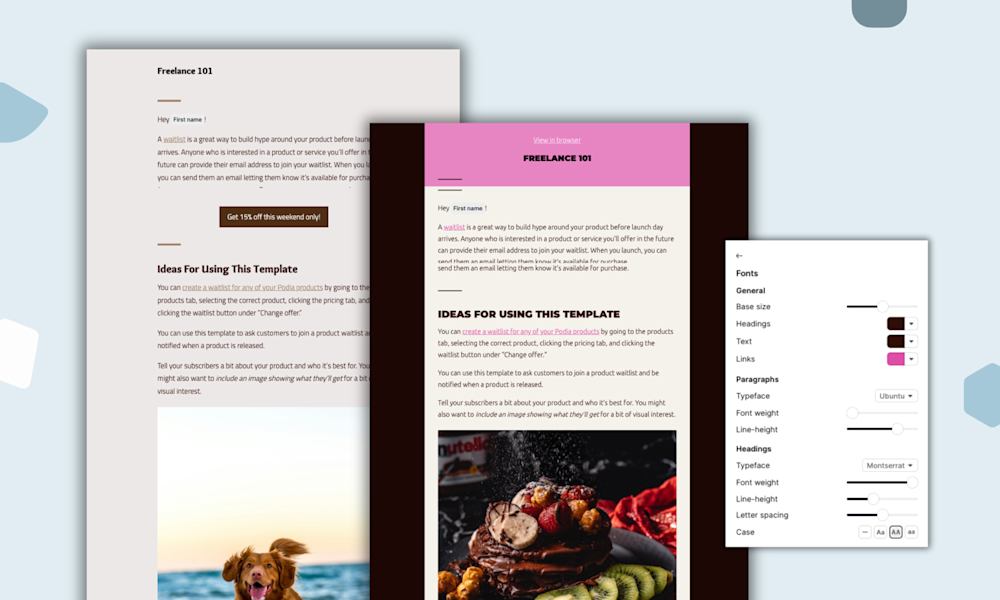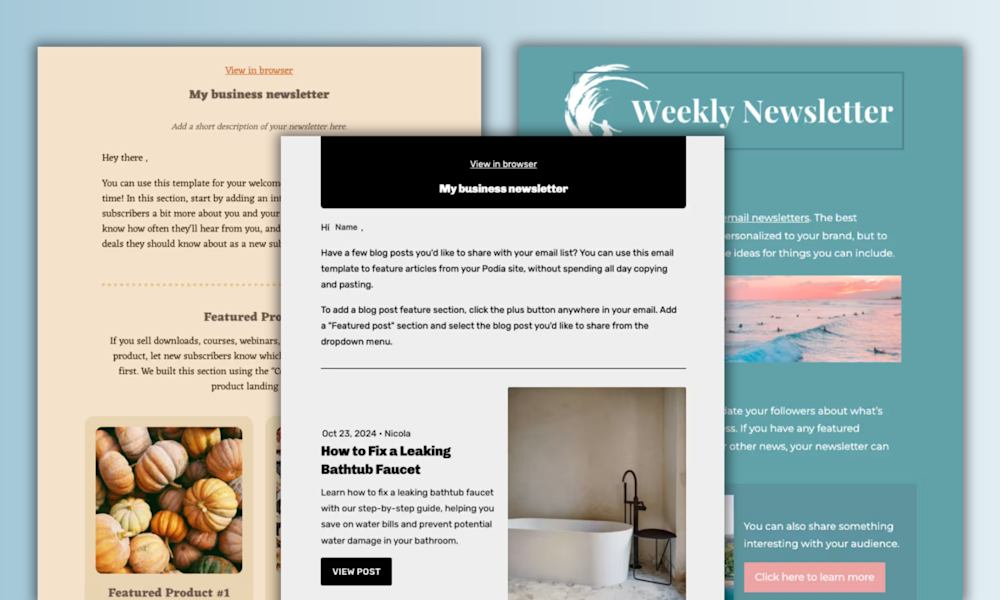You walk into your favorite ice cream joint and ask the sales staff to try a couple samples.
Then, for kicks, you ask to sample your favorite flavor.
Mmm, yes. It’s definitely the one to fill your craving, so you order a full scoop.
Allowing your audience to sample a piece of your much-needed services and products before they purchase is hardly any different.
One of the most effective ways to win people over with your brand is to offer an email course that delivers daily lessons of valuable content straight to their inbox.
If you’re wondering how and why you should offer email courses to your audience, here’s the lay of the land, starting with monetizing your email list with an email course.
But first, let’s very briefly define an email course, so we’re on the same page.
What is an email course?
An email course is a series of automated emails that deliver lessons on a specific topic for the duration of the course at regular intervals (usually daily or weekly).
In comparison to a full-fledged online course, an email course is a mini-course that helps students achieve a bite-sized result.
Offer email courses to make money with your email list (without relying on Facebook)
If you’re looking for ideas on how to make money with an email list, you have plenty of options to explore, including the powerful tactic of offering an email course.
One of the biggest reasons why offering an email course is an effective way to make money from your email list is you can use it as part of your sales funnel.
(As a reminder, a sales funnel is the path your visitors take to purchase your products or services. From your customer’s perspective, it’s their buyer’s journey.)
So, if you’re offering a free email course, you can use it as a nurturing step to your paid offer, just like you would a lead magnet.
For a great example, consider the following three-part email course by the founder of Mirasee, Danny Iny.
In the final email of his email course, he expresses that there’s much more to cover on the topic than he “can cover in a single email (or an entire email course!),” which makes the natural next step purchasing a paid product. In this case, the offered paid product is a live LIFT event.
If a freebie isn’t your speed, you can make money from your email list by offering a paid email course and sell it to your audience for a fee, just like Highbrow does.
With a paid Highbrow membership, you can access their database of email courses across several topics.
Whether paid or unpaid, though, the concept of offering an email course is still the same -- it provides a scaled-down version of your more premium products.
This gives your audience a taste of your services and strengthens the trust among your audience, an imperative ingredient to earning sales.
To earn your recipient’s trust, simply prioritize delivering a quality email course that gets your students their desired results. (Easier said than done, we know.)
Good quality products and services are the number one reason why consumers trust brands.
Sadly, too many brands miss the mark when it comes to building trust. While a staggering 81% of consumers claim trust is an important part of their purchase behavior, only one-third of them trust the brands they buy.
This means there’s a huge opportunity for your brand to deliver trustworthy high-quality products to beat out your competition.
By solving your email course students’ problems in a mini-course that’s delivered straight to their inbox, you’ll also find your engagement level is much higher than you would get using social platforms -- even the giant ones, like Facebook.
On Facebook, an engagement rate of above 1% is considered good, and 0.5-0.99% is average. In email, conversely, the average open rate is 21.33% across industries, with an average click rate of 2.62%.
With engagement numbers like that, choosing email as your delivery channel seems like a no-brainer, right? It’s a great way to get new people hooked on your brand.
In sum:
Monetize your email list without using Facebook (or other social platforms) by offering an email course as part of your sales funnel that leads to one of your flagship products, such as a profitable online course.
Upselling your full online course isn’t your only option for making money from your email list, though. You can also upsell and cross-sell your other relevant products, which brings us to our next topic today.
Provide free email courses to sell more products
If you’re wondering if you should offer free email courses, the short answer is: yes, if you want to sell more products.
This works especially well if you focus on delivering value and results to your students. The rationale behind it is that if your free stuff is this good, your paid products must be that much better.
OK, so the reason why free email courses work is the same reason for offering any other free product to sell bigger paid products, right? Well, sort of.
Sure, there’s less of an opt-in hurdle when you’re offering a free product, which makes it an effective way to get new people to interact with your brand and win them over.
In fact, according to a BYU study, offering free samples has both an immediate and sustained impact on boosting sales.
But, when you offer a free email course, you can enjoy added benefits -- such as higher engagement and longer relationships with your customers.
In addition to scoring higher engagement levels than social channels, email continues to be the main driver of both customer acquisition and retention for businesses, with over 80% of SMBs claiming email marketing as the top online activity.
What’s more, email is still the preferred channel for receiving updates from brands, and more than 50% of people check their email more than 10 times daily.
So, people are actively scoping out what’s coming into their inbox and ready to interact with any worthwhile content. If you deliver a high-quality email course, you’ll prime your audience for getting hooked on your brand, purchasing a product, and becoming a paying customer.
And when you get a paying customer hooked on your brand, the next best course of action is to take it a step further and turn them into lifetime value customers by upselling and cross-selling your other products.
Think it’s not worth the hassle? Think again. On average, 70-95% of revenue comes from upsells and renewals.
On top of renewal business bringing in the bulk of revenue streams, there’s also a greater chance that your customers will purchase new products over new prospective customers.
The probability of selling to one of your existing customers is 60-70%, which trumps the 5-20% probability of selling to someone new.
Another perk to upselling and cross-selling is it’s cost-effective. It costs businesses five times more to attract new customers than it is to retain existing ones.
OK. Now that you’re (hopefully) convinced offering free email courses to upsell and cross-sell is the way to go, check out how successful entrepreneur, Dean Graziosi, uses his free Better Life Week email course to upsell his Better Life Journal.
The key here is to follow in Dean’s footsteps and match your paid offer to your student’s need or pain point in the email course. He even uses the same “Better Life” name in both his free email course and paid product.
People who are interested in personal development and living a better life are more than likely interested in using a tool to help them get there.
Basically:
Offer free email courses to upsell and cross-sell more of your products, turn your customers into loyal repeat customers, and increase your cost-efficiency.
So that covers the why of offering email courses. As for the how, start by learning from the pros.
Copy other successful email courses to create your own
To create a successful email course, we recommend taking a cue from leaders before us and copying bits and pieces from other examples of successful email courses.
For instance, Brennan Dunn’s Charge What You’re Worth email course is an excellent example of a compelling free email course.
Let’s point out what we’d mimic. First, his landing page lets his audience know exactly what to expect from his automated email course. Brennan outlines in plain sight his offer of “straightforward advice on how to start or grow a freelancing business”.
Then, as soon as you hit the “let’s go!” CTA button, Brennan explains on his registration page what you’ll be receiving in the first lesson, prior to you submitting your contact info to register.
His thank you page also does a great job of telling you what to expect. As soon as you land, you receive a message notifying you that your first lesson is on its way to your inbox. He even calls out the title of the email and who it’s from, so there are no surprises.
I checked my inbox for my first lesson and, sure enough, it looked exactly as Brennan described.
Another detail Brennan’s email course does exceptionally well is it uses the power of personalization.
Brennan uses a multi-step form to tailor his email course to students that opt-in. For instance, the first question he asks is, “are you making a full-time income freelancing?” and then he asks conditional follow-up questions depending on your answer.
From there, he ships off a tailored nine-lesson free course, which is -- as promised -- personalized to your needs.
But, even if you don’t have a fancy multi-step form that segments your audience before they opt-in, you can still gather info from your students to tailor subsequent email lessons to them.
For example, before Brennan signs off at the end of his first email lesson, Brennan offers another bit of personalization by allowing his recipients to choose their email course pace.
Even though his email course is set up to wait 24 hours before sending the next lesson, he allows his audience to head straight to the second lesson without having to wait to receive it. They can jump ahead by simply filling out a quick form, provided by a link in the email.
Finally, another great detail you can mimic from Brennan’s email course is his level of interaction.
Brennan’s first lesson gives a homework assignment, which is a way to get your recipients to engage with you and yet another way to find out even more about his audience.
He asks his email course students to reply with more info about who they are and what they need to gain from the course.
Brennan can mine through his gathered audience data and learn more about how to better serve them and create products around fulfilling their specific needs.
I’d say that’s a pretty engaging and personalized experience.
If you’re looking for a more standard way to create an email course, beyond copying the greats, treat it like any other mini-course and follow three simple steps.
First, just as you would come up with an online course idea, brainstorm a topic for your email course.
To do this, you can look at your other products for sale and choose a topic that’s already bringing in revenue. Or you can conduct market research and survey your audience to find out what they’re most interested in.
Another option is to use our favorite Passion/Profit Matrix to plot your ideas and choose one that excites you from the top right quadrant.
Next, plan your course content by starting with the end result you want to deliver to your registrants. Remember, treat your email course like a mini course with a realistic result your students can achieve with daily or weekly emails.
Finally, build out your course content and format them to fit into emails that you’ll deliver on a regular schedule for the duration of your course.
In a nutshell:
To create a successful email course by following in the footsteps of others, you can learn from others like Brennan and tell your students exactly what to expect, being explicit in your language, and mining useful data from your registrants to create a personalized experience.
Additionally, create your email course in three steps by ideating your course topic, planning your course content, and building out your lessons to be delivered by email.
How to use Podia to set up and send your email course
Delivering your email course is a cinch with an all-in-one platform like Podia.
Let me show you what I mean.
As usual, start on your Podia dashboard.
Then, create a drip email campaign for your email course content by first heading over to the “emails” menu and clicking on the “drip campaigns” tab. After that, click “create a drip campaign”.
From there, select “drip campaign,” enter a name for your email campaign, and hit “create & continue”.
On the email dashboard, select a trigger from the drop-down menu and then click the purple “create drip email” button.
This is where you begin composing your first email lesson. Choose the number of days you want the email to wait before sending it to your recipients after the trigger occurs.
Once your first email is composed, simply hit the “add email” in the left-hand column and repeat the process for your subsequent email lessons. When you’ve finished uploading your email course content, simply turn your “email status” to “on” and tada, your email course is live.
Told you it was a cinch.
Package up your expertise into a tasty bite-sized email course
While there are several ways to entice new audience members to become loyal paying customers, offering an email course is a tactic that’s sure to satiate your customers’ appetite.
Let’s review:
-
An email course allows you to give your audience a sampling of your products and services in the format of educational email lessons, usually daily or weekly.
-
Monetize your email list by offering an email course as a chance to nurture your audience toward your higher-ticket paid products.
-
Offer free email courses to upsell and cross-sell your other products while retaining loyal customers and saving on marketing costs.
-
To create a successful email course, learn from others who do it well and mimic the best parts. It also helps to follow three simple steps including ideating, planning lesson content, and building out your email course.
And, of course, to top it all off, use an all-in-one platform to make sending and managing your email course a breeze.
We may have a good suggestion for that, but don’t take our word for it. Find out why our 17,000+ creators chose Podia to manage their online and email courses and why you should, too, with a free trial today.



